What imagery is more dynamic than a hero in a flowing linen shirt, crossing swords with a black-clad villain? Stories of men in tights and ladies in torn bodices have long provided artists with excellent opportunities for bravura work.
What better way to showcase the illustrator’s craft than by the skillful depiction of the abundant drapery and rich detail of historical costume? A hallmark of the genre is a dramatic composition, often by means of contrapuntal gesture, clearly seen in A.B Wenzell’s wrestling pirates in “The Danger Man.” Even in a moment of stasis as in Saul Tepper’s “A Captured Knight” the pictorial tension expresses the melee before the capture and the daring escape that will no doubt follow.
N.C. Wyeth may have depicted Robert Louis Stevenson works most famously (The Black Arrow), but the Scotsman’s tales provided period fodder for many artists including George Varian (Treasure Island). As for Shakespeare’s Hamlet, interpretations abound, from Howard Chandler Christy’s rendition of the troubled Dane in 1937 to Jean Leon Huens’s puffy-sleeved version in the late 1970s.
And let us not forget the damsels in their finery. Former pulp artist Peter Stevens portrays a fierce pirate and a frightened blond in Technicolor splendor for American Weekly in the 1950s, while Elaine Duillo brings tenderness to a medieval love scene for a Dell romance novel.
Glistening steel, heaving hearts, and stolen booty–the high drama expressed by gifted illustrators can still move us—reminding us of more swashbuckling times.
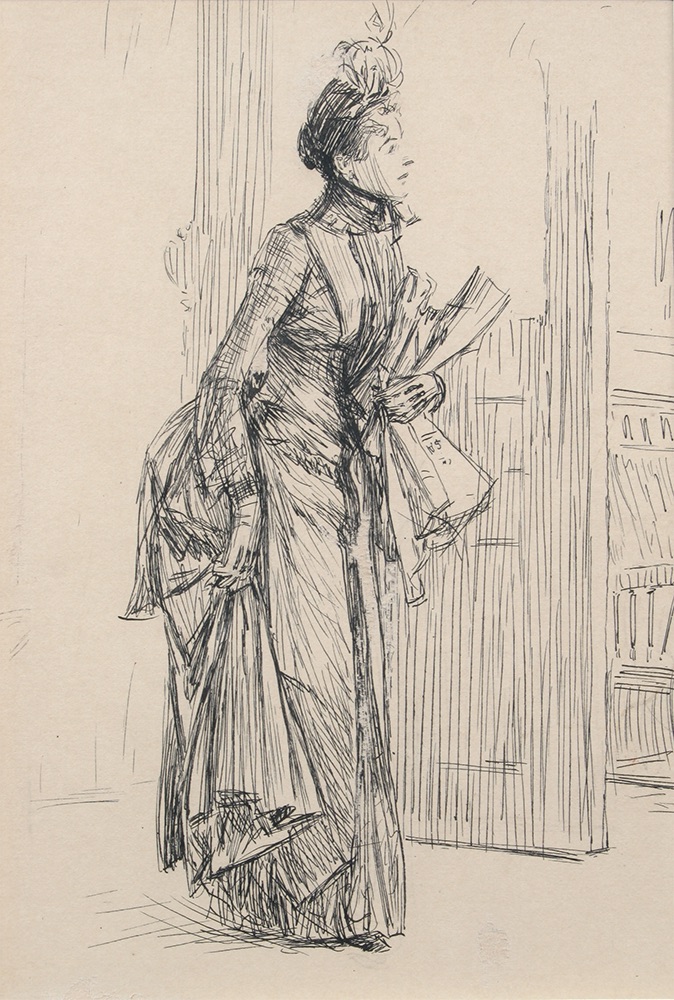
WILLIAM THOMAS SMEDLEY
(1858–1920)
“The Albany Depot:A Farce”
Illustration for the story by William Dean Howells
Caption: “Mrs. Roberts had many proofs of an afternoon’s shopping in her hand.”
Harper’s Weekly magazine, December 14, 1889.
Pen and ink on board
William Thomas Smedley was known first as an illustrator and then for his portrayals of fashionable men and women in social settings. He rode the crest of a boom in the demand for illustrations created for books, magazines, newspapers, and posters that reached its peak in America in the late 1890s. He became the Society of Illustrators first president in 1901.
JOHN RICHARD FLANAGAN
(1895–1964)
Discovery of nine men buried up to their necks in sand
Pen and ink on Bristol board
Donated by Chet Martin
Born in Sydney, Australia, he left in 1916 and traveled to America where he settled in New York City He found work as a newspaper artist. His first assignments were for Everyweek Magazine. In January of 1926, Flanagan revisited Australia, to hold an exhibition of his work. The Sydney Mail reported, ”A Gifted Australian Artist – The pen drawings and watercolours of John Richard Flanagan have attracted great attention. He is essentially a pen man, an excellent newspaper artist of the modern American school. Much of his pen work reaches a very high standard. He has the essentials of a good illustrator. His drawings are strong, and he shows good dramatic sense and characterisation, and nice decorative compositions. Having picked the right incident to illustrate, it is a much more difficult thing to ascertain the most telling moment in that incident, but this Mr. Flanagan does with unerring judgment.
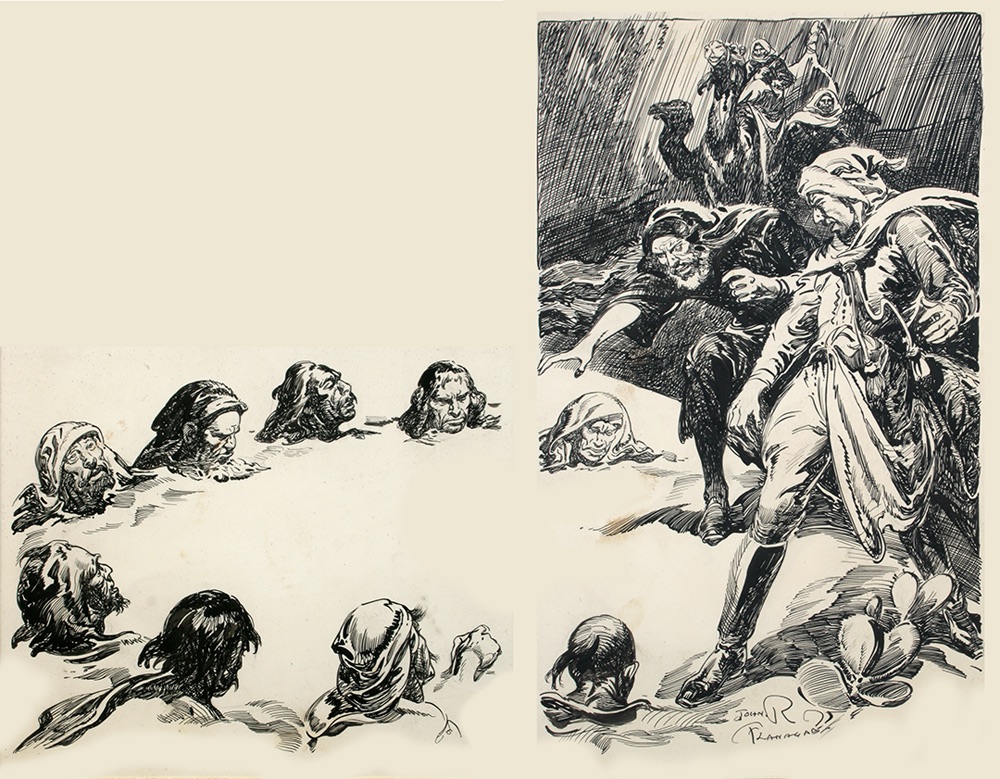
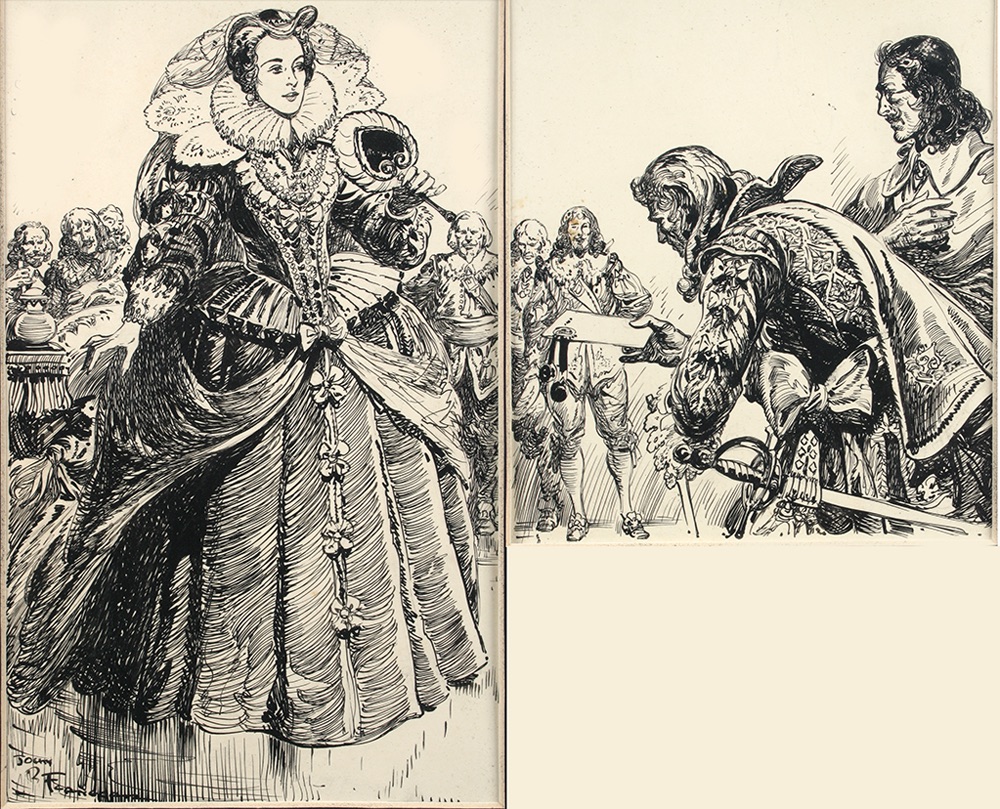
JOHN RICHARD FLANAGAN
(1895–1964)
Queen receiving emissaries to her court
Pen and ink on board
Donated by Chet Martin
Born in Sydney, Australia, he left in 1916 and traveled to America where he settled in New York City He found work as a newspaper artist. His first assignments were for Everyweek Magazine. In January of 1926, Flanagan revisited Australia, to hold an exhibition of his work. The Sydney Mail reported, ”A Gifted Australian Artist – The pen drawings and watercolours of John Richard Flanagan have attracted great attention. He is essentially a pen man, an excellent newspaper artist of the modern American school. Much of his pen work reaches a very high standard. He has the essentials of a good illustrator. His drawings are strong, and he shows good dramatic sense and characterisation, and nice decorative compositions. Having picked the right incident to illustrate, it is a much more difficult thing to ascertain the most telling moment in that incident, but this Mr. Flanagan does with unerring judgment.
SAUL TEPPER
(1899–1987)
Illustration of a captured knight
Redbook magazine, 1934
Oil paint on canvas
Donated by the artist
Known for his painstaking attention to research, Tepper most certainly had the knights’ costumes and weaponry correct. That said, the viewer is in no way overly conscious of didactic attention to that research. It’s storytelling at a high level, and this bold masterwork has all the muscularity often found in Tepper’s work, although his skill allowed him sensitivity with less masculine subjects. Here, in this full drama of a feudal conquest, his black-and-white is so rich that it almost reads as color.
An inveterate New Yorker, Saul Tepper studied at several of the excellent art schools in the city, including at the Grand Central School of Art under Harvey Dunn. After time as a letterer, Tepper established himself equally as an illustrator in both the advertising and editorial fields, with clients such as Mobil Oil, Texaco, General Motors and Coca-Cola, and for many of the national magazines of the day. With many prestigious awards to his name, he taught and lectured for many years in the area. As if a successful art career wasn’t enough, Tepper wrote popular songs that were recorded by Nat King Cole, Ella Fitzgerald, Glenn Miller, and others. This skill was put to good use at 15 annual Society of Illustrators shows, and he was inducted into the Society’s Hall of Fame in 1980.
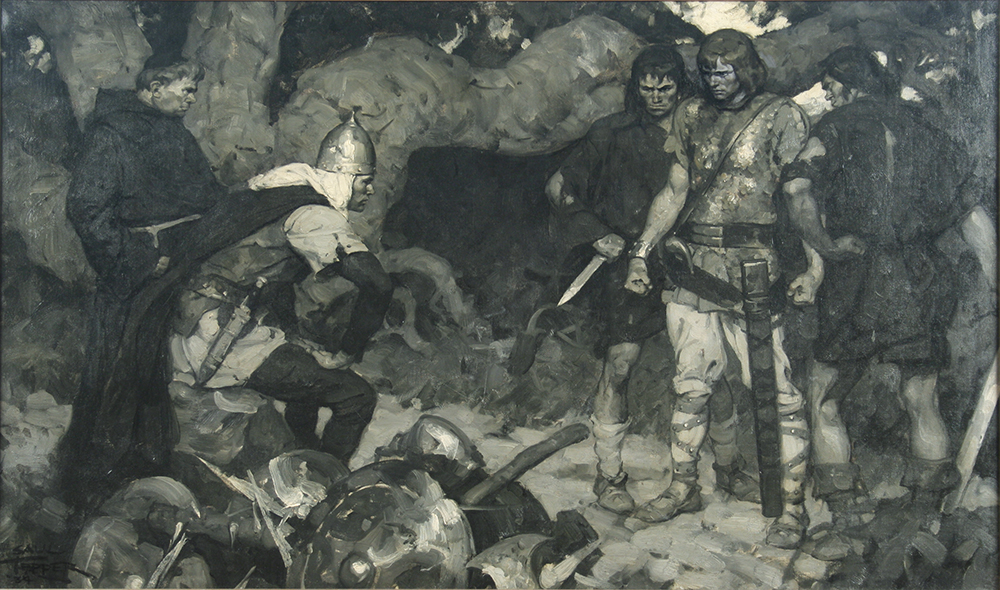
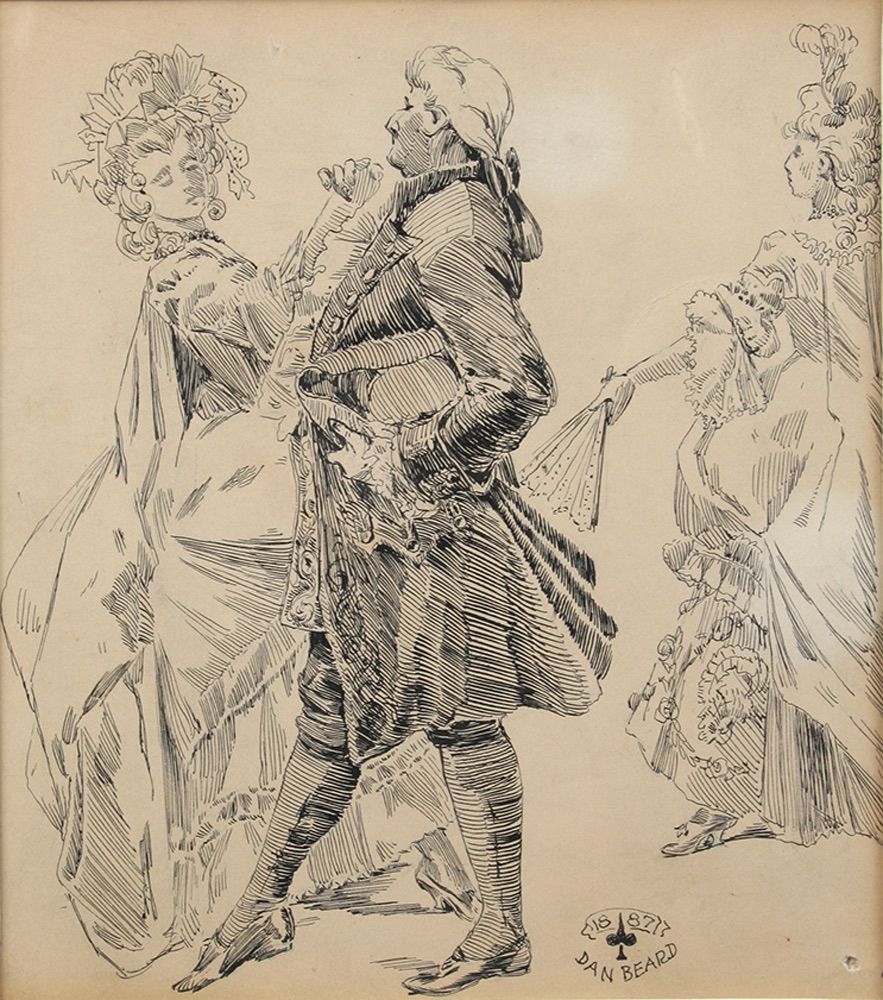
DANIEL CARTER BEARD
(1850–1941)
Dancing couple in 18th century period dress
Pen and ink
Society of Illustrators Purchase Fund.
Dan Beard was a painter, illustrator, and founded “The Society of the Sons of Daniel Boone” which developed into “The Boy Pioneers” in 1905, which then became the Boy Scouts of America in 1910 after he heard about the work of Baden Powell. His writings on the group appeared in Recreation, a magazine that he edited. He was the Boy Scouts of America’s first National Commissioner and Chairman of the Court of Honor and was the author of 21 books on outdoor living and survival skills. He was elected president of the Society of Illustrators in 1906.
ALBERT BECK WENZELL
(1864–1917)
“The Danger Man”
Oil paint on board
J. Walter Thompson Purchase Fund
For all Wenzell’s stylized composition—the central diagonal and the rhythm of the negative space—these pirates are really going at it. As the title indicates, this is a perilous fight to the finish. This work is a departure for the artist, who was best known for representing fashionable society, bringing a high standard to the representation of voluminous silk-and-satin ladies’ wear, and to the starched shirt fronts of gentlemen, as he did for Edith Wharton’s House of Mirth. Although much of his work was in black and white, his colorful oil paintings, like the furious pirates here, would have been reproduced in color.
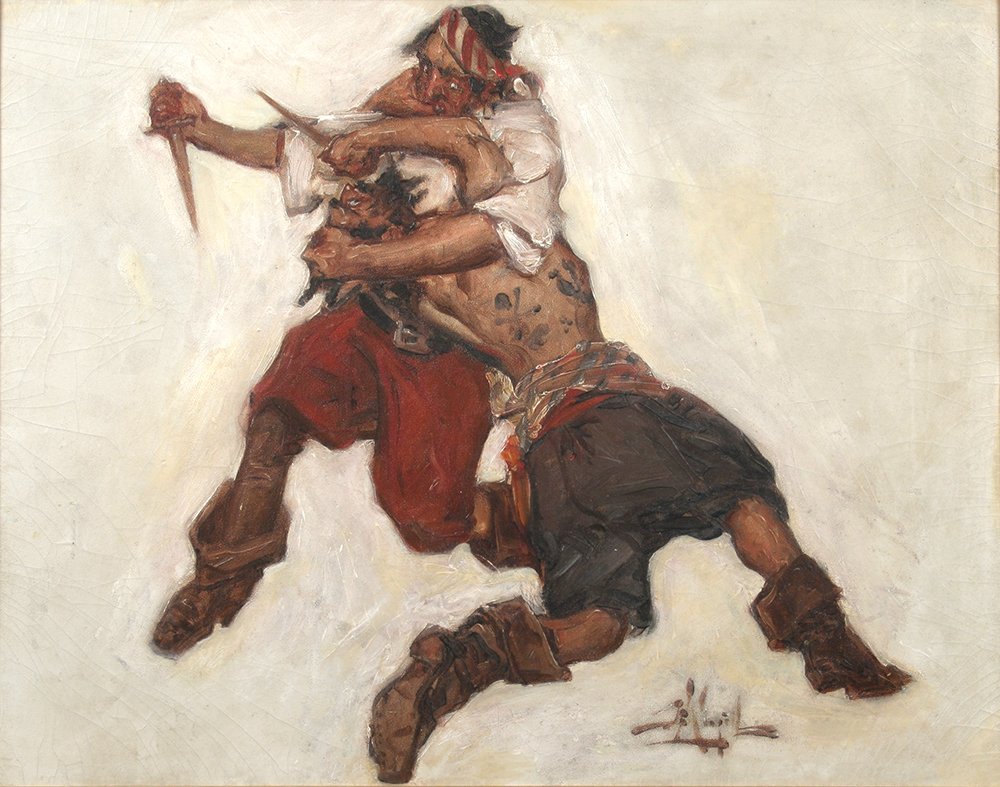
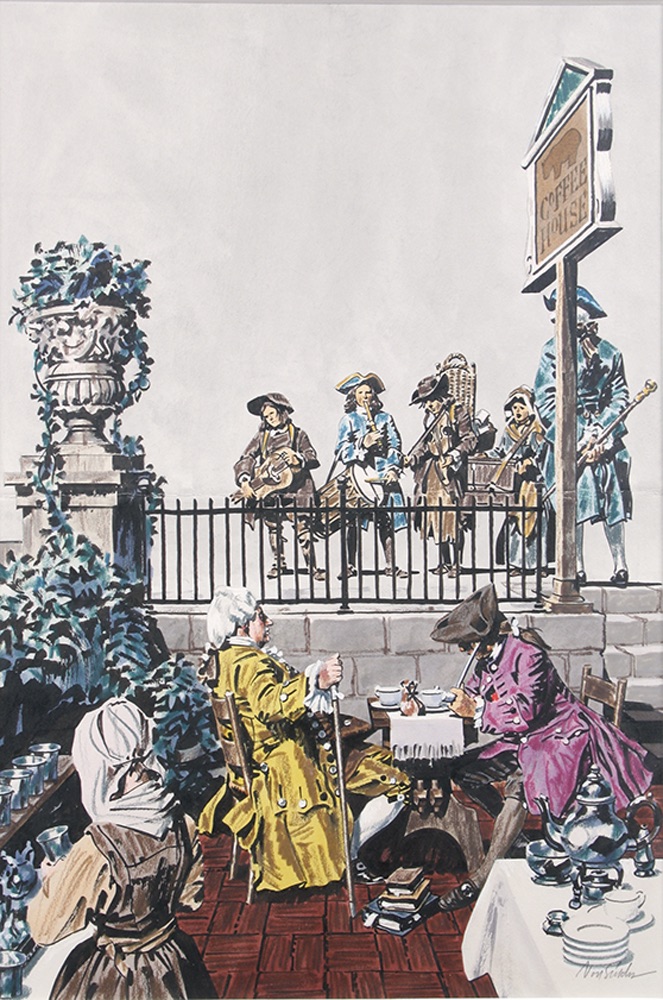
NOEL SICKLES
(1911–1982)
Reader’s Digest, unpublished
Concentrated watercolors (dyes)
Donated by Robert H. Blattner
Sickles was an American commercial illustrator and cartoonist, best known for the comic strip Scorchy Smith. Largely self-taught, his career began as a political cartoonist for the Ohio State Journal in the late 1920s. At that time, he met and shared a studio with cartoonist Milton Caniff, then working for the Columbus Dispatch. Sickles followed Caniff, creator of the Terry and the Pirates comic strip, to New York City in 1933, where both men initially worked as staff artists for the Associated Press. Sickles asked the newspaper syndicate for a salary raise in 1936, and when he was turned down, he quit, becoming a successful commercial illustrator. He also ghosted the daily strip The Adventures of Patsy, but otherwise the rest of his career was devoted to magazine illustration. For LIFE, he illustrated the original publications of The Old Man and the Sea and The Bridges at Toko-Ri.
GEORGE EDMUND VARIAN
(1865–1923)
Studies for “Treasure Island” by Robert Louis Stevenson
Watercolor on paper
Donated by Sidney Wiener
Varian was born in England and came to America in his youth. He studied at the Brooklyn Artists Guild and at the Art Students League and exhibited at the Paris Salon in 1907. His many memberships included the Brooklyn Art Club and the Salmagundi Club in New York.
George Varian had the distinction, alone with Vulcanologist Professor Angelo Heilprin and reporter August laccaci, to witness and record the eruption of the volcano at Mt. Peleé in Martinique, in May of 1902, narrowly escaping death from one of the many subsequent eruptions. The report andpictures were published by McClure’s magazine that August. The rest of Varian’s career, if less adventuresome, was long and productive. He illustrated for most of the major magazines of the day including McClure’s, Scribner’s, St. Nicholas, and The Century.
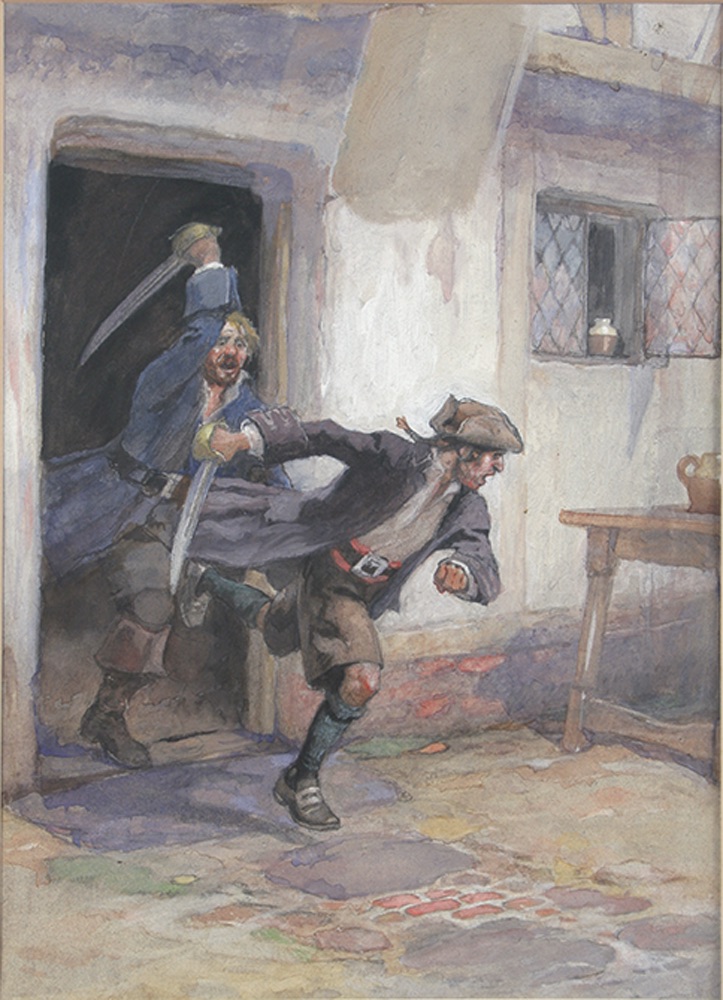
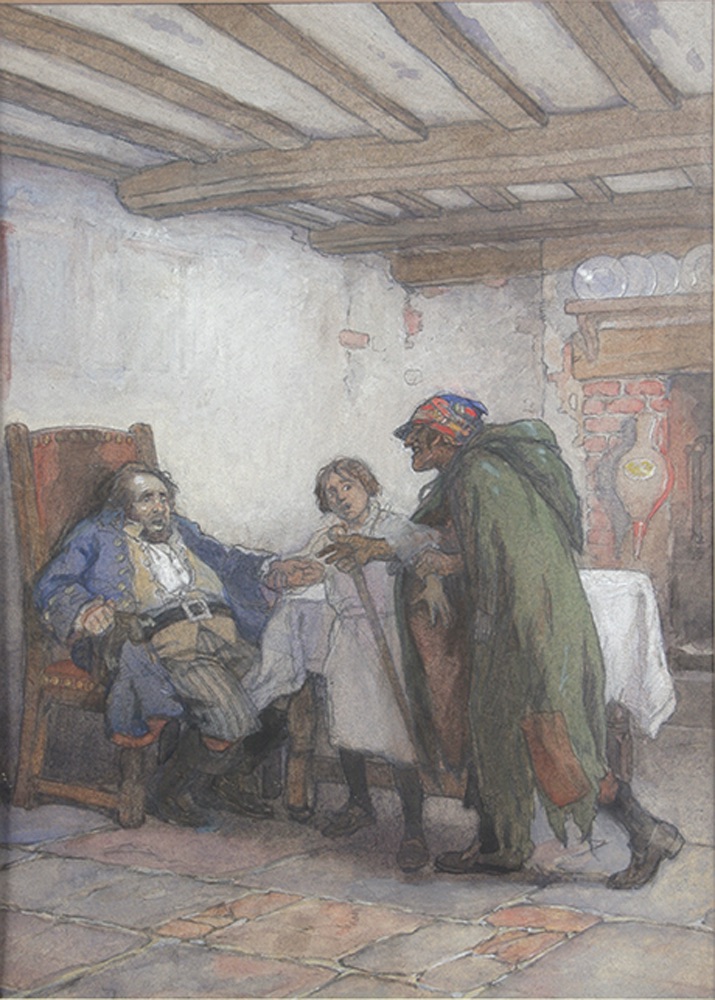
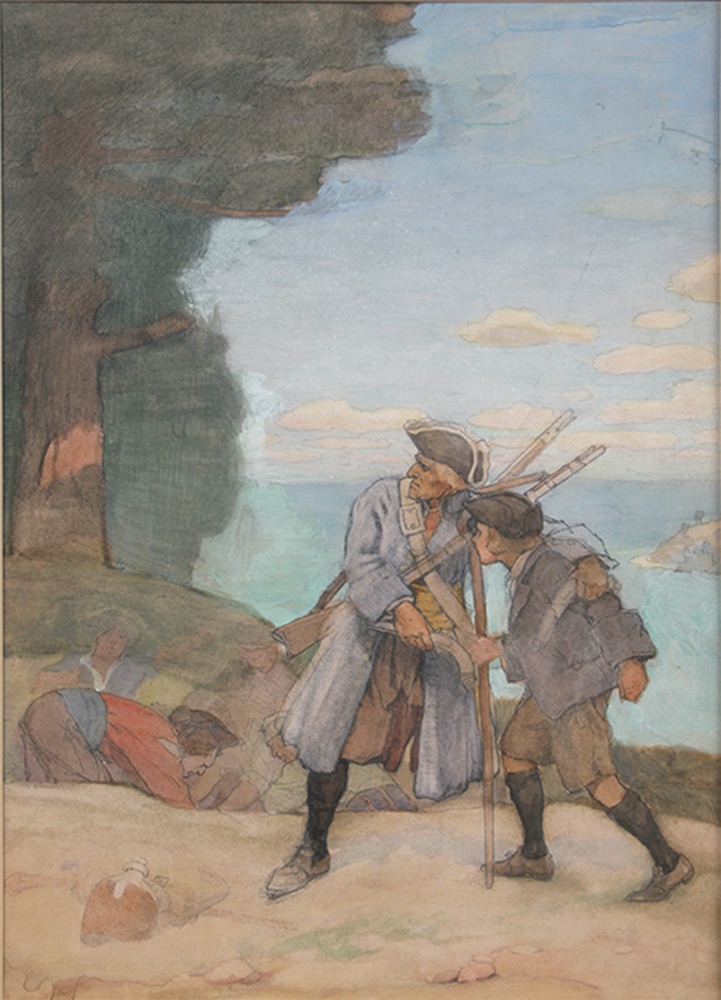
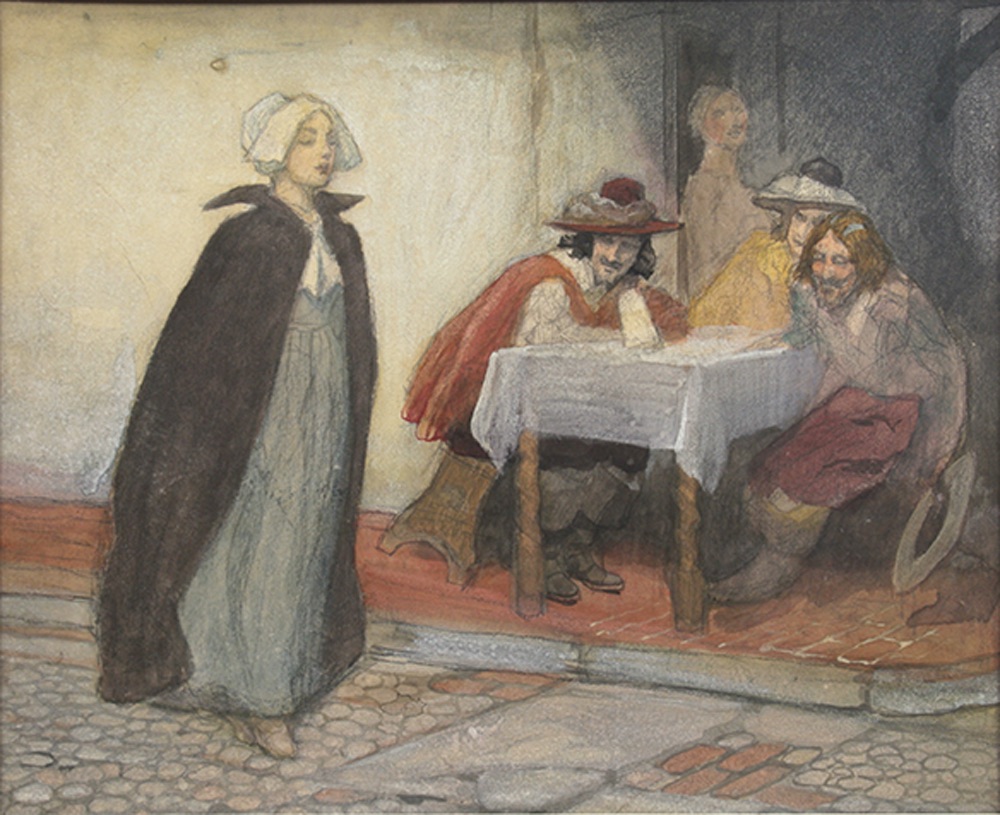
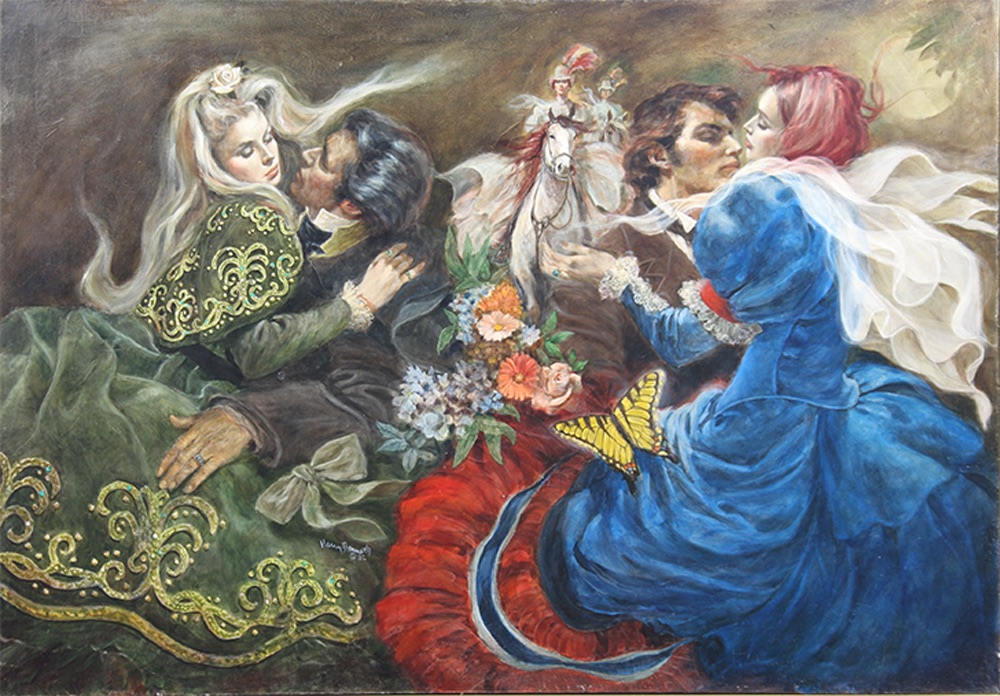
HARRY R. BENNETT
(1925–2012)
“Kindred Spirits”
Wraparound book cover design for the book by De Ann Patrick.
Pocket Books, 1982
Oil on canvas
Donated by the artist
After serving in the military during WWII, his wife encouraged him to follow his passion for painting. He attended The Art Institute of Chicago and The American Academy of Art Chicago. He would use his family and neighbors as models for over 1000 book covers and illustrations over the years. He was best known as an internationally published illustrator who painted large scale covers for the big publishers of the paperback industry at the time including, Simon and Schuster, Western Printing and Avon Press. He painted covers for various authors including Jude Deveraux, Mary Stewart, Phyllis Whitney, and Victoria Holt and illustrated the first paperback edition of Mario Puzo’s The Godfather. In 1966, he was awarded a bronze metal by the Society of Illustrators for the ink paintings he created to illustrate a boxed collectors’ edition of Dante’s Divine Comedy.
FELIX OCTAVIUS CARR (F.O.C.) DARLEY
(1822–1888)
“Marooned”
Ink wash on paper
J. Walter Thompson Co. Purchase Fund 1986 Grant
Darley was a self-taught and prolific artist who started out as a staff artist for a Philadelphia publishing company where he was given a wide variety of assignments. After he moved to New York, his work began to appear in magazines such as Harper’s Weekly and in books by various publishers. Darley made 500 drawings for Lossing’s History of the United States. Among his lithographic illustrations are those for Irving’s “The Legend of Sleepy Hollow”, and some scenes in Indian life. The swing and vigor of his style, his facility, and versatility and the high average merit of his numerous works, make him one of the most noteworthy of American illustrators. Over his career, he produced nearly 350 drawings for James Fenimore Cooper. In 1868 he published, after a visit to Europe, Sketches Abroad with Pen and Pencil. His watercolor paintings of incidents in American history are full of spirit and his bank-note vignettes are also worthy of mention.
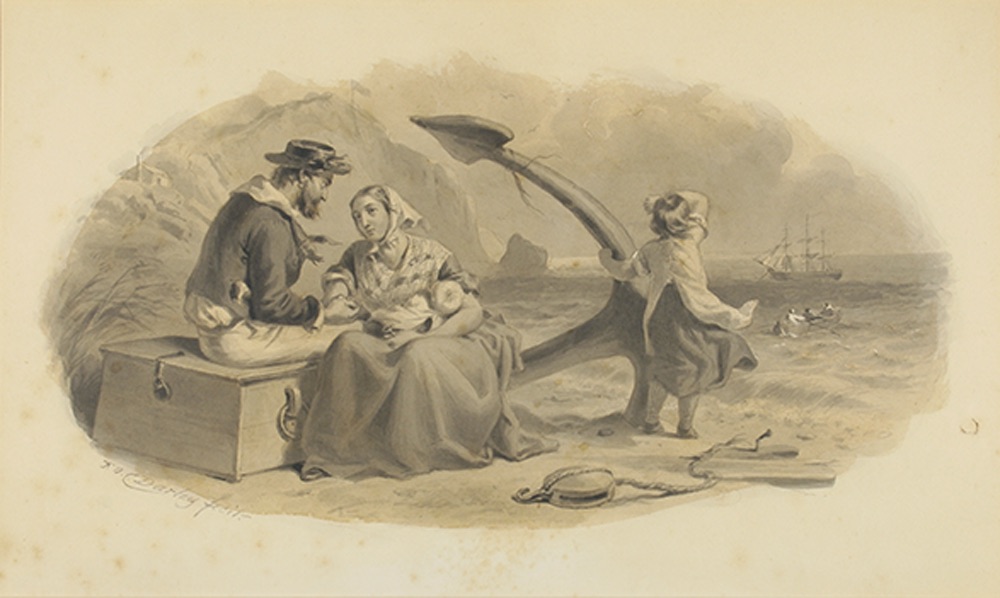
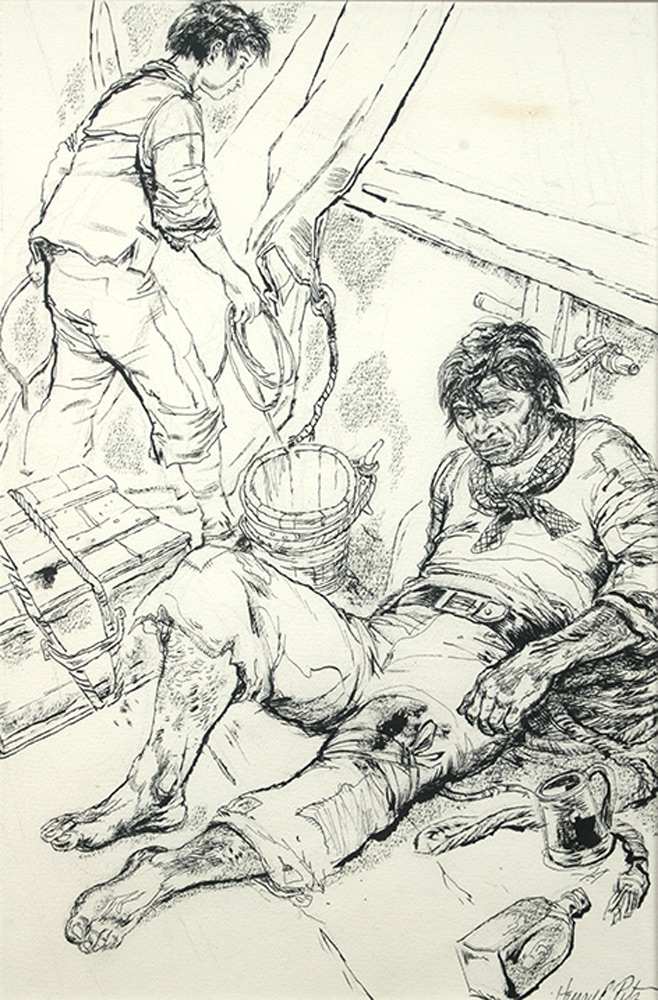
Pen and ink on paper
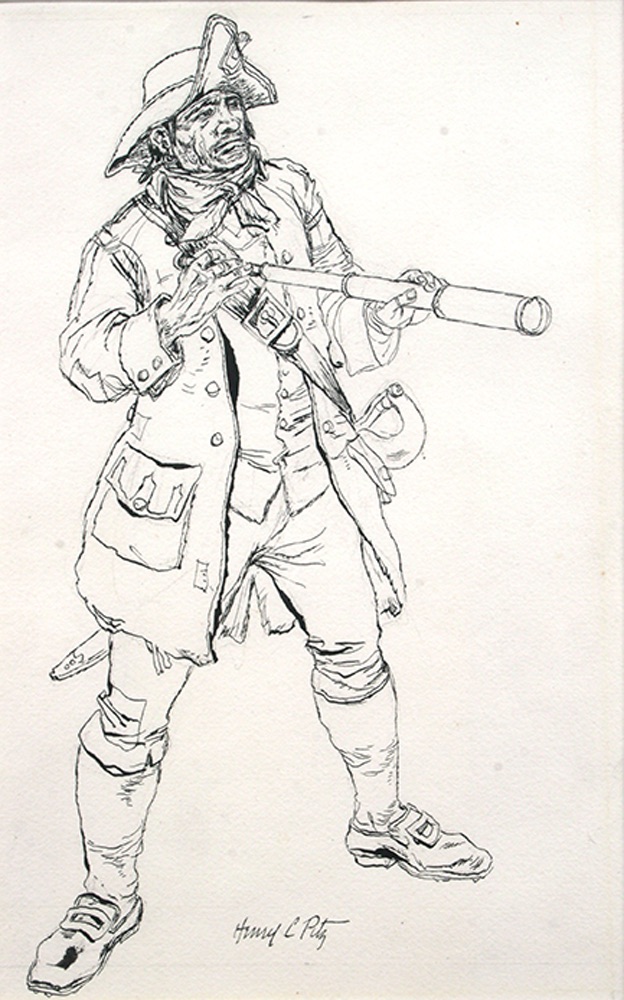
Pen and ink and charcoal pencil on paper
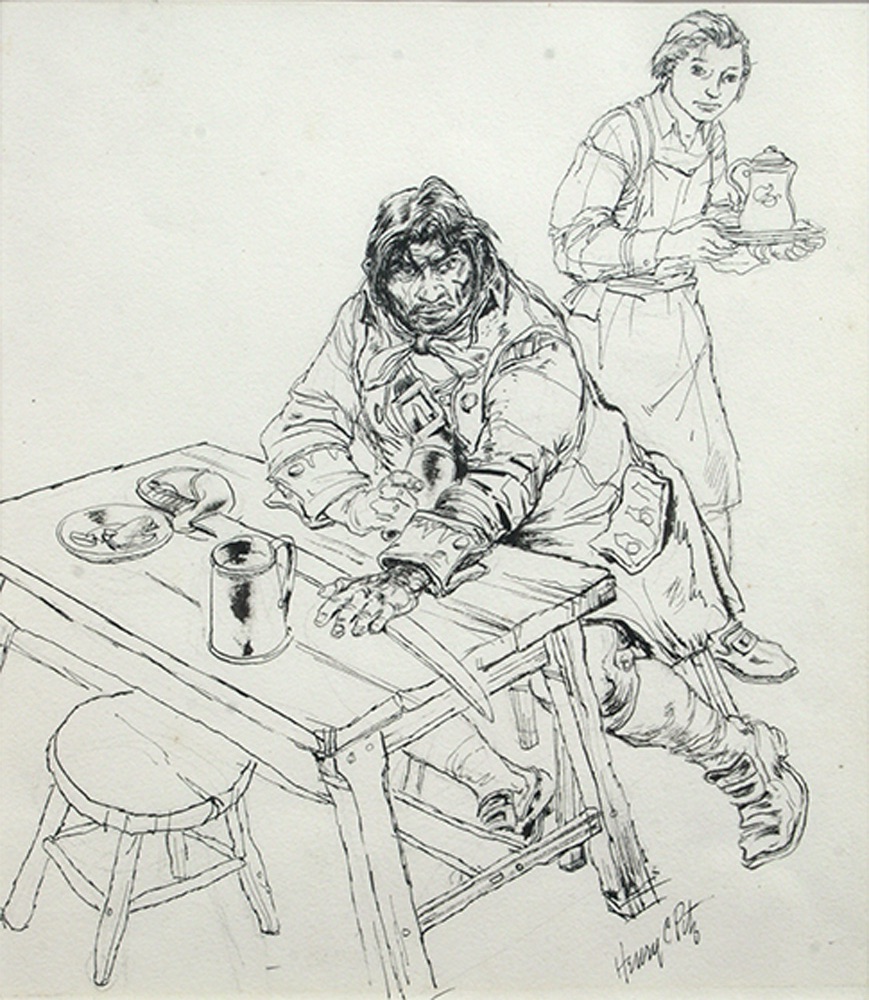
Pen and ink and charcoal pencil on paper
GEORGE EDMUND VARIAN
(1865–1923)
Studies for “Treasure Island” by Robert Louis Stevenson
Watercolor on paper
Donated by Sidney Wiener
Varian was born in England and came to America in his youth. He studied at the Brooklyn Artists Guild and at the Art Students League and exhibited at the Paris Salon in 1907. His many memberships included the Brooklyn Art Club and the Salmagundi Club in New York.
George Varian had the distinction, alone with Vulcanologist Professor Angelo Heilprin and reporter August laccaci, to witness and record the eruption of the volcano at Mt. Peleé in Martinique, in May of 1902, narrowly escaping death from one of the many subsequent eruptions. The report andpictures were published by McClure’s magazine that August. The rest of Varian’s career, if less adventuresome, was long and productive. He illustrated for most of the major magazines of the day including McClure’s, Scribner’s, St. Nicholas, and The Century.
KATHARINE STURGES KNIGHT
(1890–1979)
Mother getting children ready to go outside
Watercolor and pencil on illustration board
Donated by Hilary Knight
Katherine Sturges Knight was born in Chicago and eventually traveled to Japan to study Oriental art. Her Illustrations for Little Pictures of Japan, published by The Book House for Children, were inspired by this trip. In addition to children’s book illustrations and greeting cards, she created fashion drawings for Harper’s Bazaar, and award-winning advertising illustrations for McCallum Hosiery and Oneida Community Silver. She was commissioned by Macy’s to visit South America to design jewelry and fabrics based on Peruvian artifacts. Mrs. Knight collaborated with her husband on fabric designs and books related to his field of aviation history, toile depicting the career of President Eisenhower that was used in Blair House, and she was the first American to design for Spode of China.
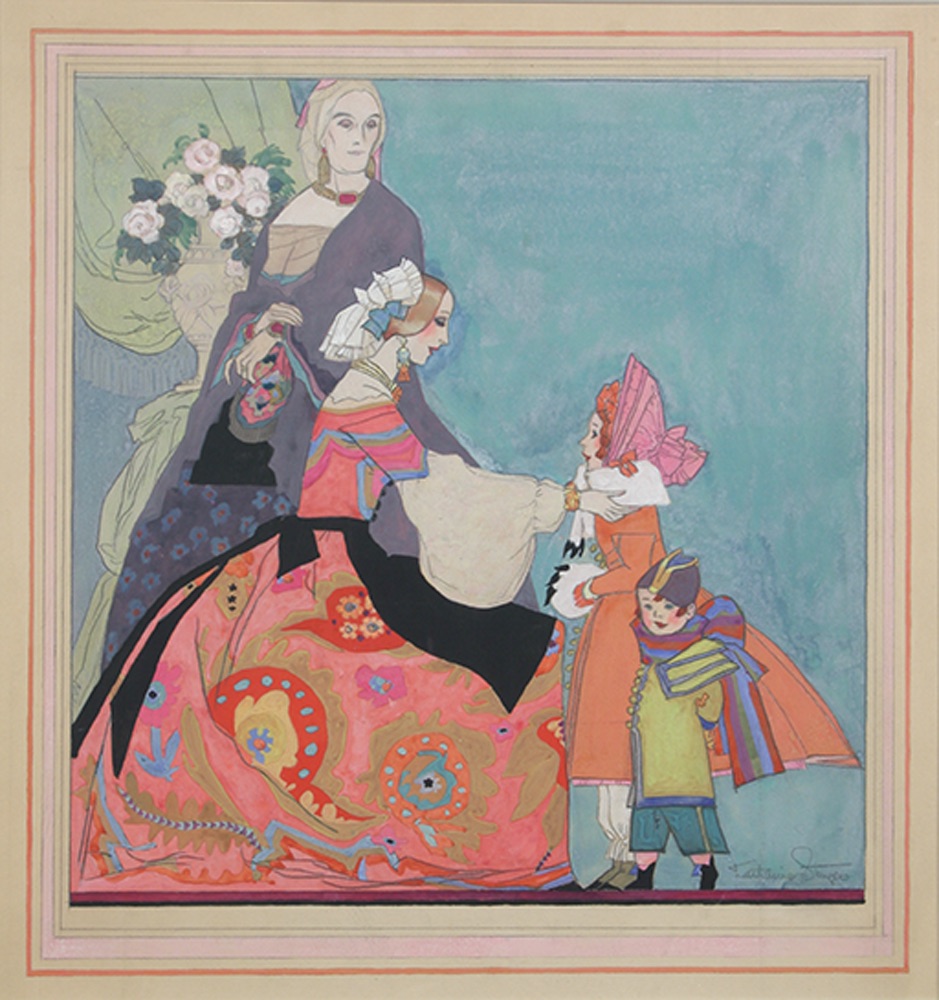
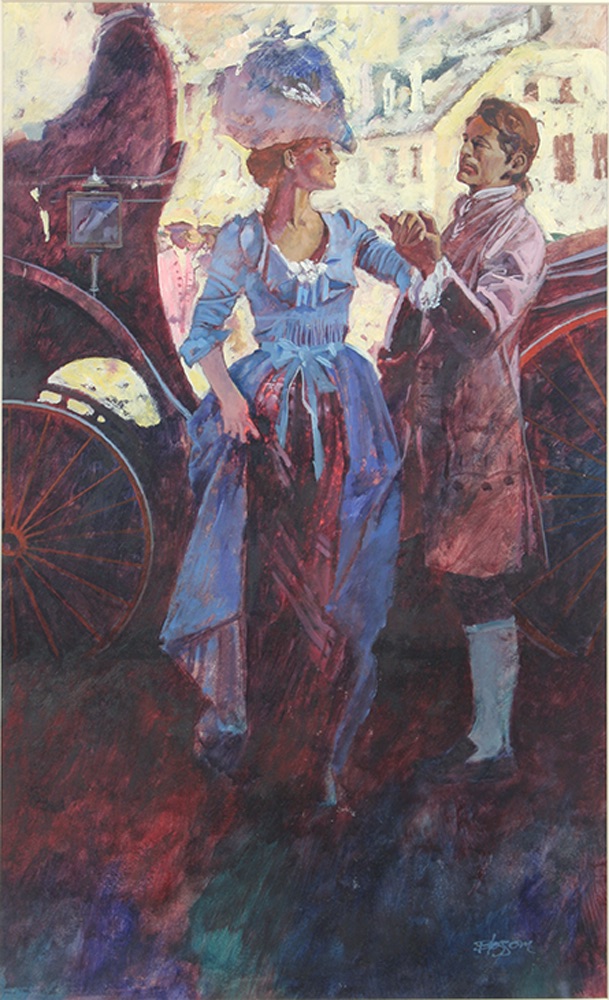
DAVID J. BLOSSOM
(1927–1995)
“Duchess Polly”
Oil on board
Donated by the artist
David Blossom worked at Young & Rubicam as an art director for the Ford Motor Company and Pan American Airways accounts until moving to Weston, CT when he became a freelance illustrator. He created romance paperback book covers and Western themes (later in his career) and is also known for his movie posters (early Clint Eastwood spaghetti westerns, The Good, The Bad, and The Ugly, A Fistful of Dollars and A Few Dollars More among others) and magazine covers.
HEIDE OBERHEIDE
(b.1957)
“Something Wicked”
Cover illustration for the book by Susan Johnson
Oil on Canvas
Penguin
Donated by the artist
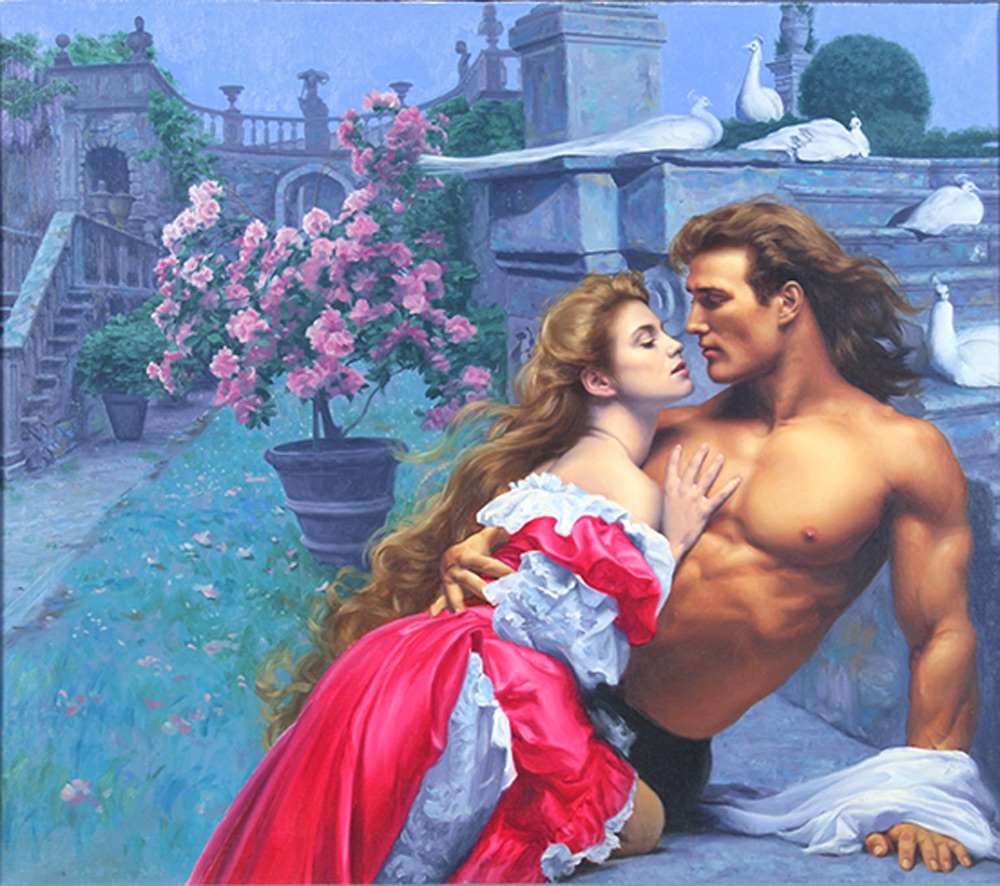
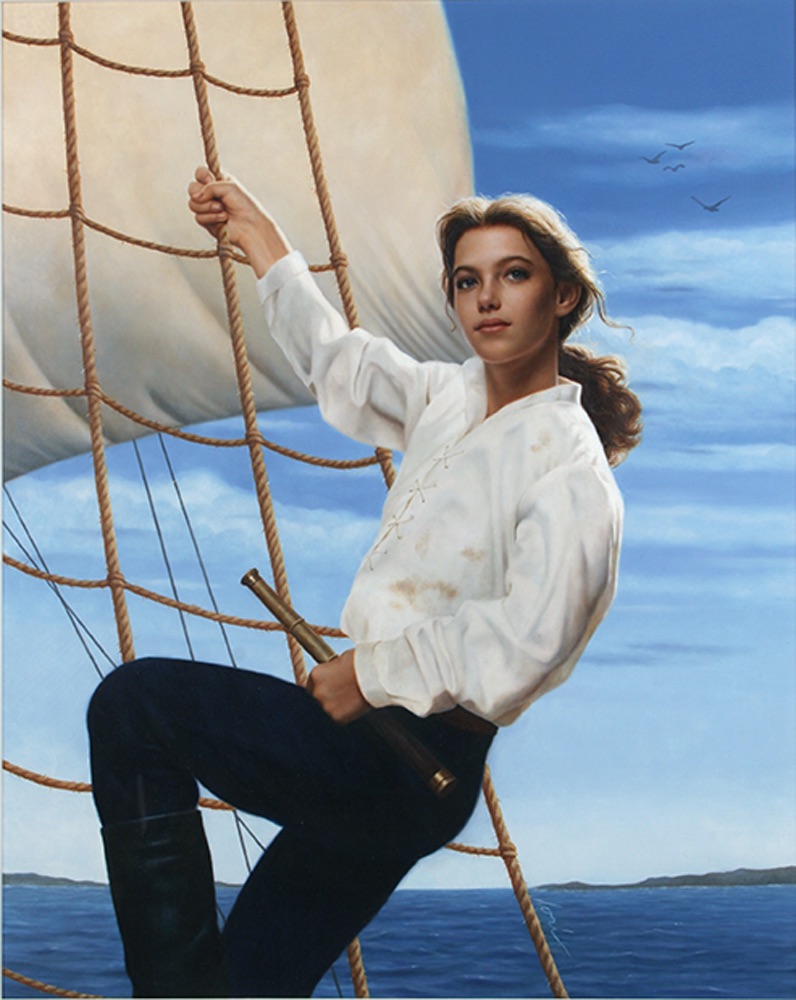
LORI EARLEY
(20th C.)
“The True Confessions of Charlotte Doyle”
Cover illustration for the book by Avi
A Spellbinding Tale of Intrigue and Murder on the High Seas
Oil on board
Avon Books
Donated by the artist
As 12-year-old Charlotte travels on a long, grueling sea voyage from England to Rhode Island in 1802, she transitions from a prim and proper English girl to a confident, swashbuckling mate. The crew is mutinous, the captain accuses her of murder, and she is actually brought to trial—not the usual life of any young lady anywhere.
WILLIAM ARTHUR SMITH
(1918–1989)
Illustration for a paperback edition of Hamlet by William Shakespeare
Bantam Books, c. 1960s
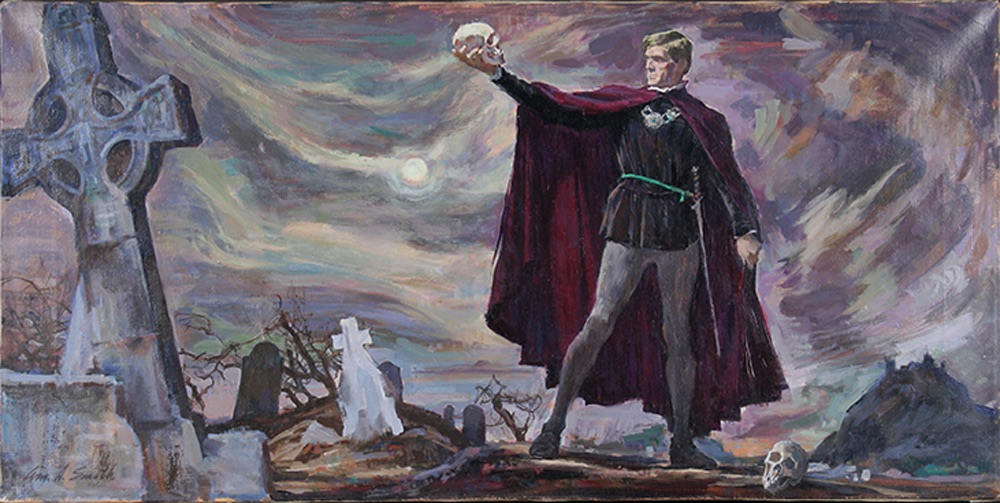
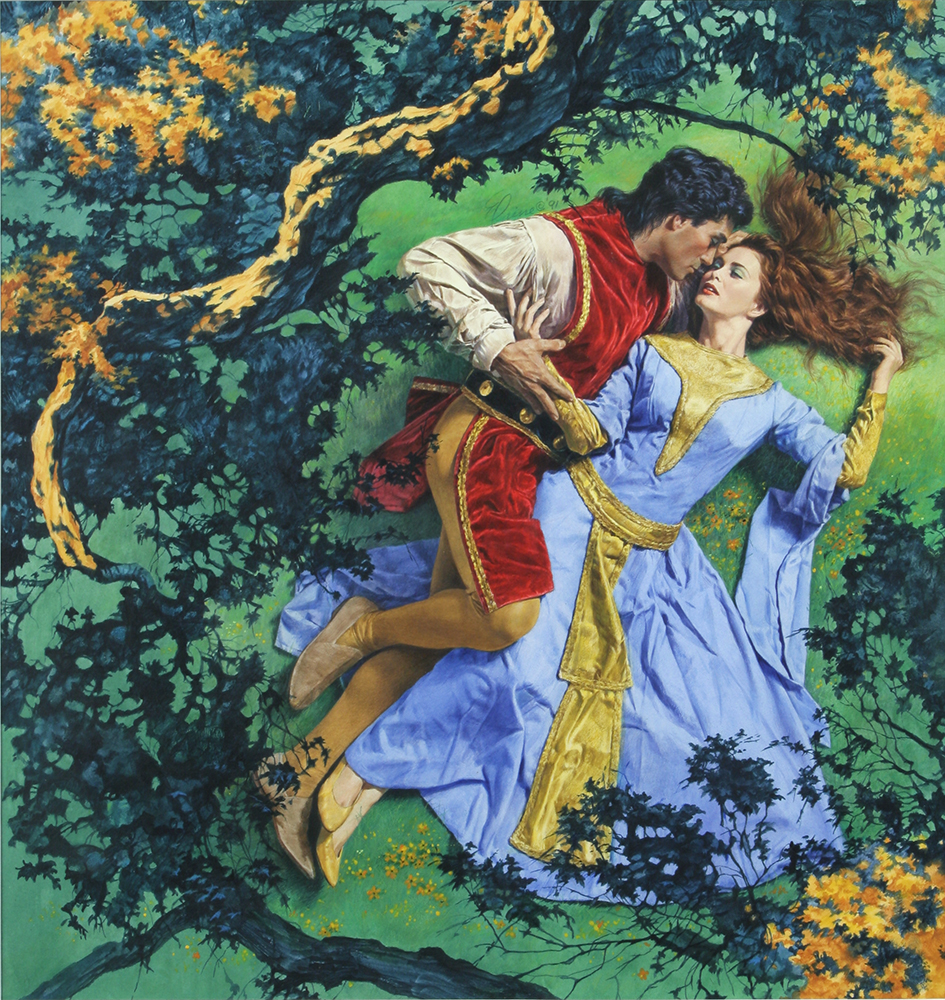
ELAINE DUILLO
(b.1928)
“Keeper of the Dream”
Paperback cover illustration for the novel by Penelope Williamson
Dell Publishing, 1995
Acrylic on board
Donated by the artist
A graduate of Pratt Institute, Elaine Duillo has had assignments from every major publisher in the US and abroad. Her stylish covers are instrumental in getting many authors on the bestseller lists, including that of The New York Times. She has been featured in People magazine and on Fox-TV as well as several cable stations. Her artwork is considered the pinnacle of Romance Novels cover illustration
EDWIN AUSTIN ABBEY
(1852–1911)
“Portrait of a Girl in White” 1895
Pastel
Donated by the Estate of Anne Fogel
Born in Philadelphia, Edwin Austin Abbey found early success as a staff artist at Harper’s, where he would hone his skills with such masters as A.B. Frost and Howard Pyle. A trip to England in 1878 resulted in annual visits there to gather research and props for his historical work, and in 1882 Abbey made the move permanent. He was distinguished for the enormous murals he created for the Boston Public Library, Buckingham Palace in London, and at the State Capitol in Harrisburg, Pennsylvania, which, unfinished at the time of his death, was completed by his friend, John Singer Sargent. He was inducted into the Society of Illustrators Hall of Fame in 1979.
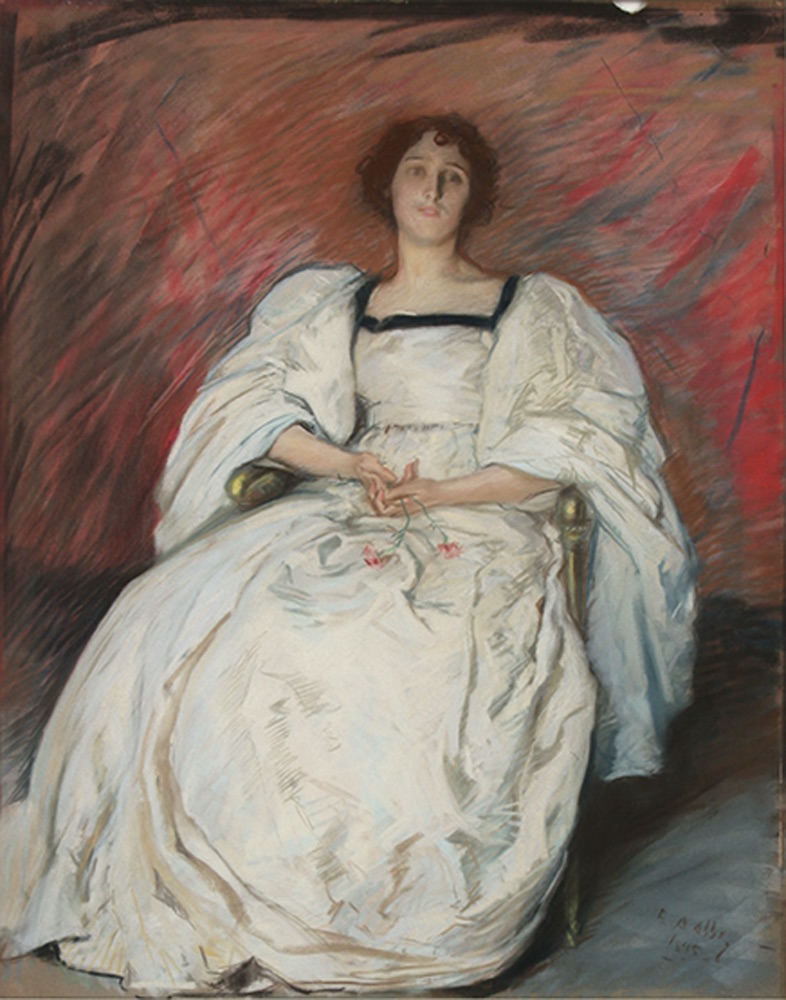
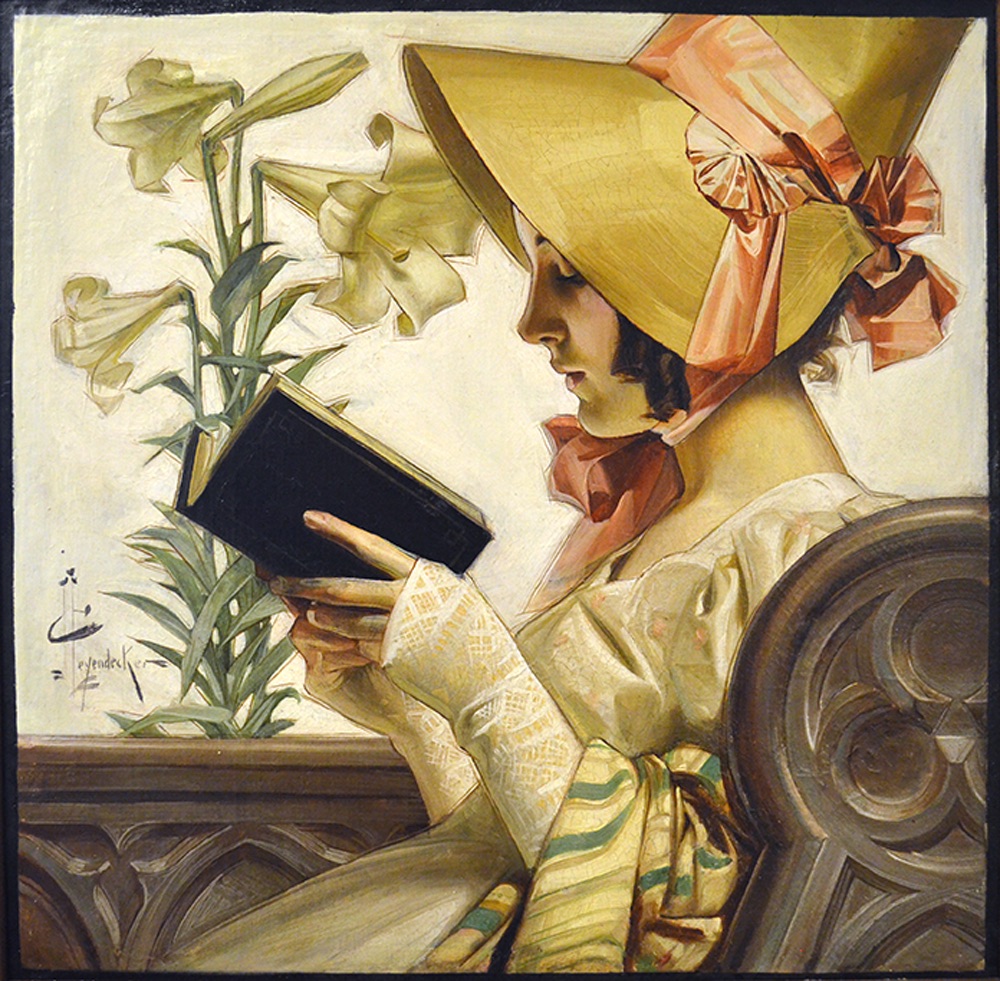
JOSEPH CHRISTIAN LEYENDECKER
(1874–1951)
“Easter”
Cover for The Saturday Evening Post, April 22, 1905
Oil paint on board
Museum of Illustration Purchase Fund
This is one of Leyendecker’s first Easter covers for The Saturday Evening Post. He was to complete dozens more, often applying his most imaginative ideas to that season. Here, he has surrounded the figure with a tracery of wispy black lines, which serve to soften the edges and simultaneously give them more graphic emphasis. Much of this power was lost in the magazine reproduction, which employed only two colors of ink.
FRANK BRANGWYN
(1867–1956)
“Old Salts”
Story illustration for “Captain Dick and Captain Jacka” by A. T. Quiller-Couch
Caption: “‘What do’ee think?’ asked Mr. Job, still slanting his eye down his nose—’I’ll go home an’ take my wife’s opinion,’ said Cap’n Jacka’”
The Graphic, December 1898
Oil paint (en grisaille) on board
Museum of Illustration Purchase Fund
Brangwyn was an artistic jack-of-all-trades. As well as paintings and drawings, he produced designs for stained glass, furniture, ceramics, table glassware, buildings and interiors, was a lithographer and woodcutter and was a book illustrator. It has been estimated that during his lifetime Brangwyn produced over 12,000 works. His mural commissions would cover over 22,000 square feet of canvas, he painted over 1,000 oils, over 660 mixed media works (watercolors, gouache), over 500 etchings, about 400 wood-engravings and woodcuts, 280 lithographs, 40 architectural and interior designs, 230 designs for items of furniture and 20 stained glass panels and windows.
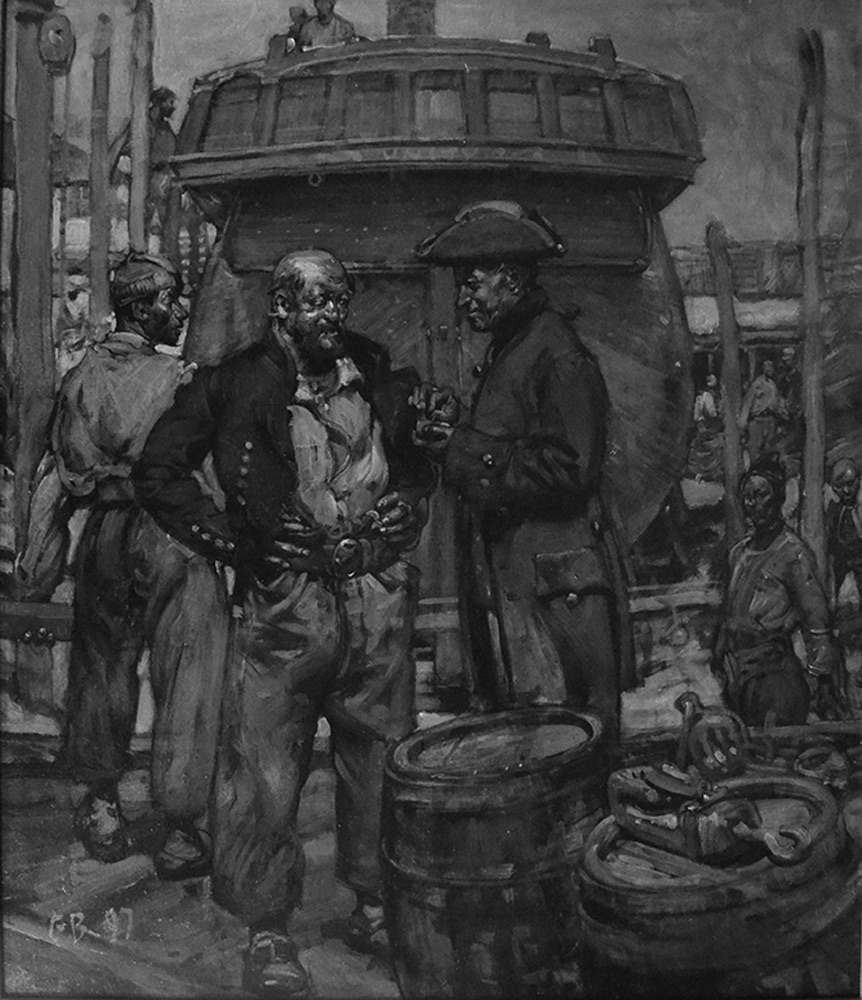
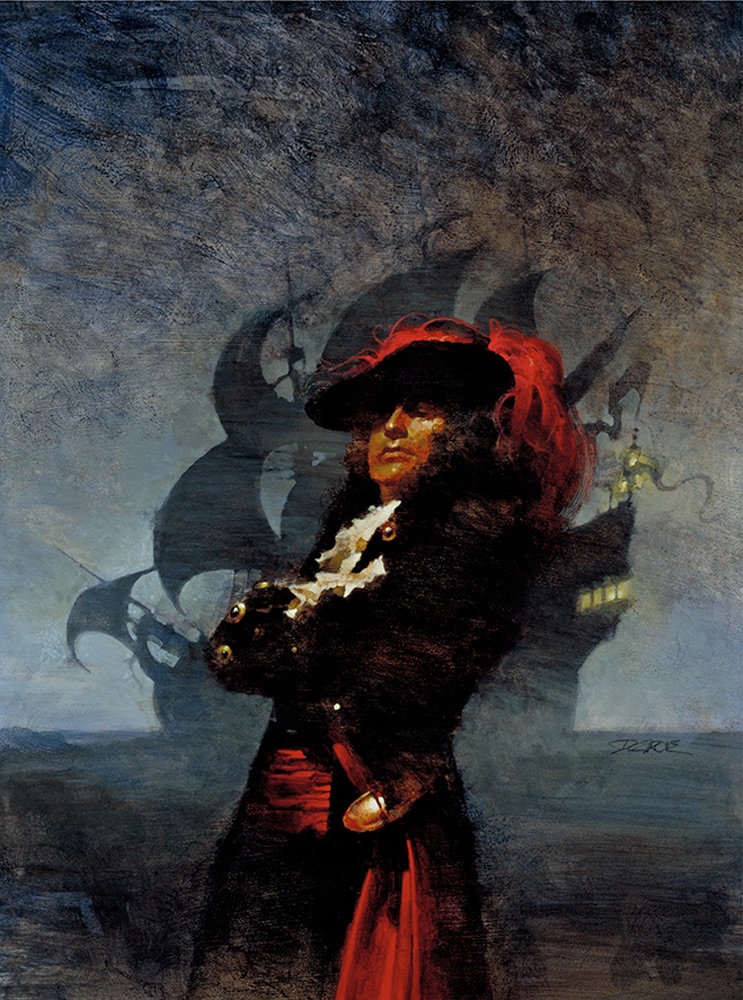
DAVID GROVE
(1940–2012)
“Captain Blood”
Cover illustration for the paperback by Rafael Sabatini
BantamBooks, 1976
Gouache and acrylic on gessoed illustration board
Donated by The David Grove Illustration Trust
Grove was born in Washington, D.C. and attended the Syracuse University School of Art. In 1964, he took a year off to travel in Europe but stayed on in Paris for several years as freelancer. Following another stint in London with Artist Partners Ltd., he returned to the States—to San Francisco—and the west coast had been his home base ever since. There he worked for a wide range of clients, such as Car and Driver, The Saturday Review, Bantam Books, Ballantine Books, Dell Publishing Company, Standard Oil, the U.S. Navy, the Atlantic Richfield Co., Western Airlines, NFL Properties, Inc., Pendleton Woolen Mills, CBS, the Bank of America and Walt Disney Productions. Grove also taught at the Academy of Arts College in San Francisco and was a member of both the San Francisco and New York Society of Illustrators and the Graphic Artists Guild.
DAVID GROVE
(1940–2012)
“Pirate Freedom”
Illustration for the book by Gene Wolf
Tor Books, 2007
Gouache and acrylic on gessoed illustration board
Donated by The David Grove Illustration Trust
Grove was born in Washington, D.C. and attended the Syracuse University School of Art. In 1964, he took a year off to travel in Europe but stayed on in Paris for several years as freelancer. Following another stint in London with Artist Partners Ltd., he returned to the States—to San Francisco—and the west coast had been his home base ever since. There he worked for a wide range of clients, such as Car and Driver, The Saturday Review, Bantam Books, Ballantine Books, Dell Publishing Company, Standard Oil, the U.S. Navy, the Atlantic Richfield Co., Western Airlines, NFL Properties, Inc., Pendleton Woolen Mills, CBS, the Bank of America and Walt Disney Productions. Grove also taught at the Academy of Arts College in San Francisco and was a member of both the San Francisco and New York Society of Illustrators and the Graphic Artists Guild.
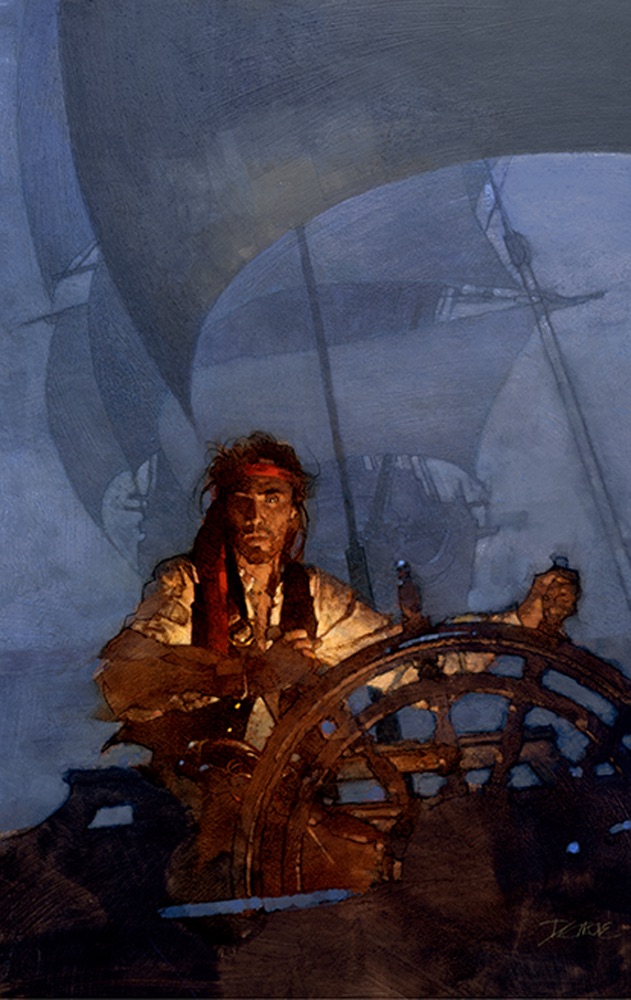
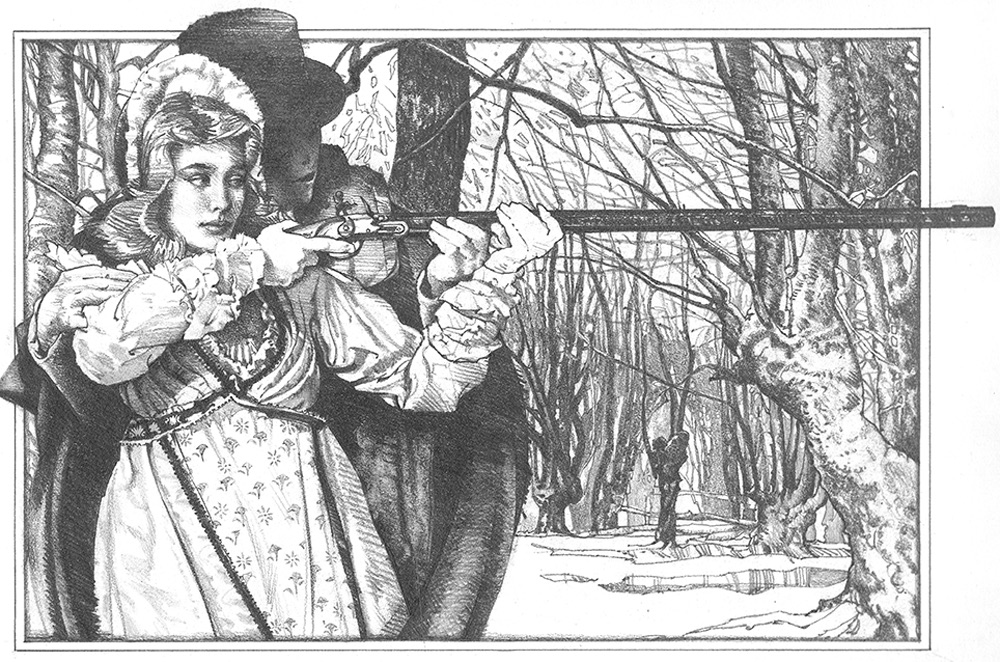
BERNARD D’ANDREA
(1923–2016)
“A Rose in Winter”
Good Housekeeping, 1982
Pencil on Bristol board
Donated by Lisa Harlow Stark
Bernard D’Andrea had a long and varied career that began well over a half-century ago. A native of Buffalo, NY, he showed artistic talent early on in a nurturing atmosphere. Reward for his efforts was winning a national competition from Scholastic Magazine: a full scholarship to Pratt Institute in Brooklyn, NY. He was pulled out of school by the Army and inducted into the technical school of the U.S. Quartermaster Corps as an Army artist. While in the Army he illustrated Army manuals and designed war posters. After his discharge in 1947 he received his diploma from Pratt Institute. He returned to New York City and joined the prestigious Charles E. Cooper Studio, which represented future Society Hall of Famers such members as Coby Whitmore, Joe DeMers, Joe Bowler, and Lorraine Fox, D’Andrea’s wife, whom he’d met at Pratt and married in 1951.
After two years of advertising work, D’Andrea launched a successful career as an editorial illustrator. He held longtime relationships with the top magazines of the time such as The Saturday Evening Post for 15 years and Good Housekeeping for over 40 years. During what he calls “the glory days of illustration” and citing Saturday Evening Post covers as an inspiration, his work appeared in Boy’s Life, Redbook, Cosmopolitan, Woman’s Home Companion, McCall’s and Seventeen.
HOWARD CHANDLER CHRISTY
(1873–1952)
“Hamlet, Act II”
Caption: “Can you play the murder of Gonzago?”
Barse and Hopkins, New York, 1897
Pencil on paper
J. Walter Thompson Purchase Fund
This piece, published in 1897, is from the early part of Christy’s career; one could argue that it predates his well-deserved fame. Nonetheless, the immediate and direct depiction of the Act II scene in Shakespeare’s Hamlet underlines the defining point of this portion of his career—to show things as they are and not as they ideally could be.
Howard Chandler Christy was a master of a variety of media and subject matter. In his early career he focused mainly on reportorial subjects; for Scribner’s and Leslie’s Weekly he created on-the-spot drawings of Teddy Roosevelt and his Rough Riders when they invaded Cuba. More so than many of his contemporaries, Christy sought out the spotlight and in so doing was able to go beyond narrative story illustration into portraiture. His well-heeled clients were the household names of the day, notables from Amelia Earhart to Benito Mussolini. His ability to sumptuously depict the female form meant his “Christy Girls” were in great demand in such publications as McClure’s and others. Christy’s frolicking nymphs still grace the walls at The Leopard at des Artistes restaurant in New York. A more sober mural, The Signing of the Constitution, hangs in the rotunda of the Capitol in Washington, D.C. Christy was inducted into the Society of Illustrators Hall of Fame in 1980.
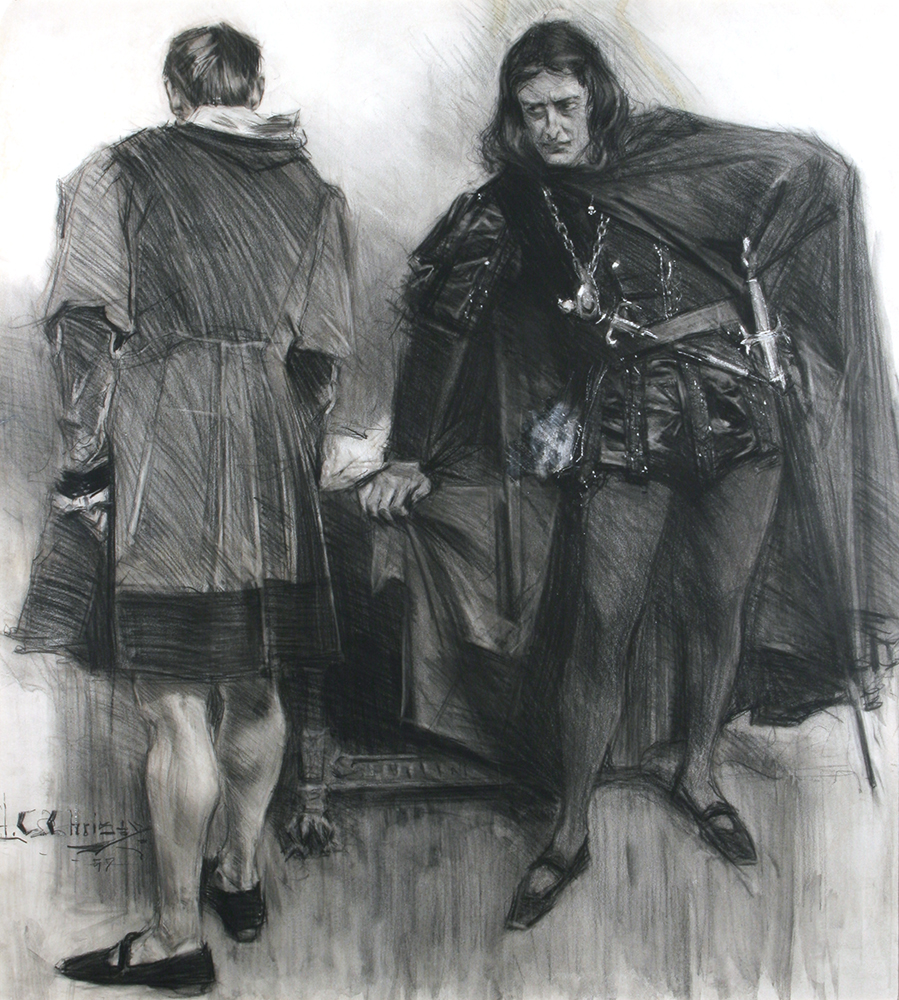
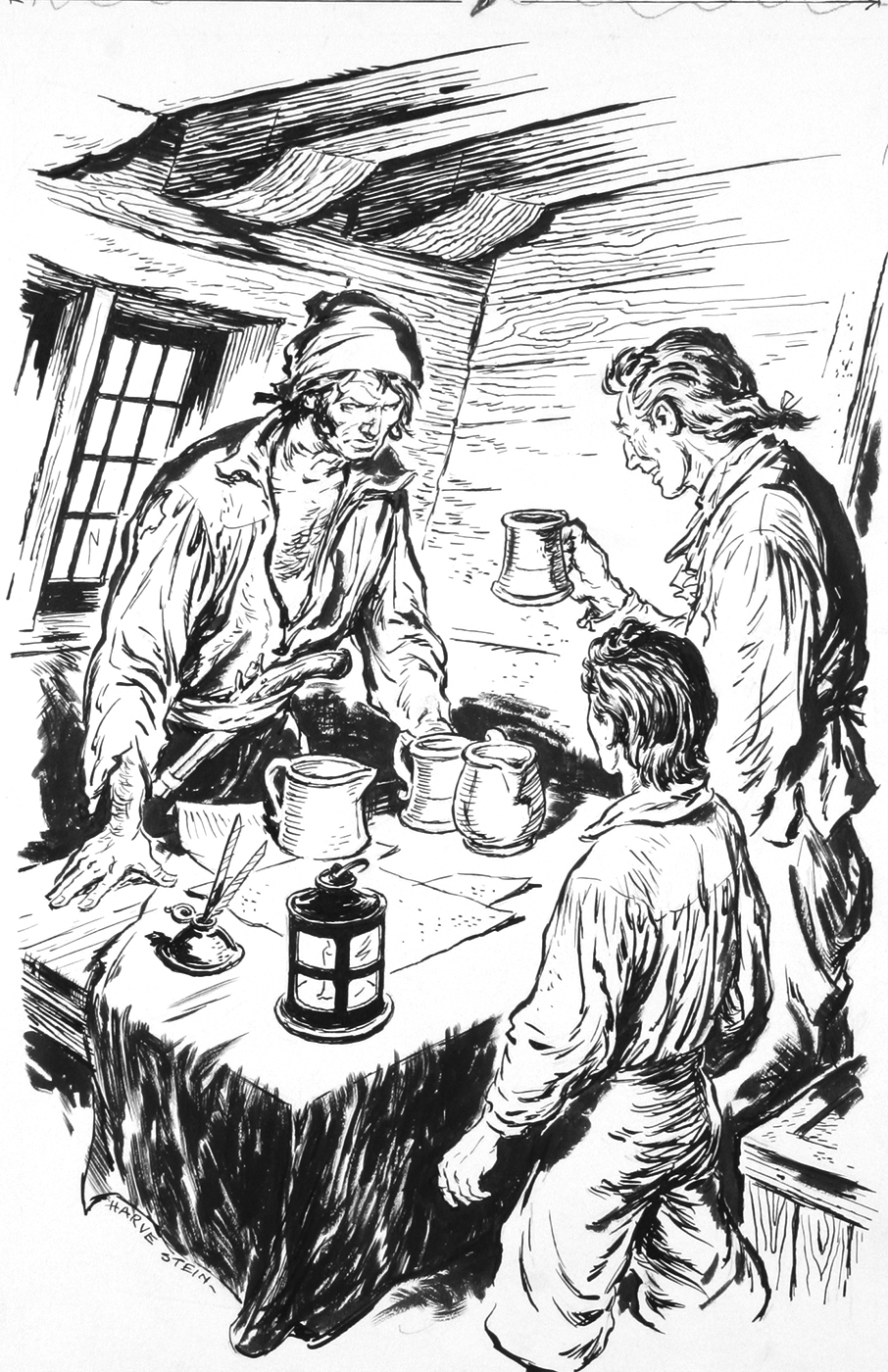
HARVE STEIN
(1904–1996)
Caption: “‘To piracy,’ He said and smiled at Hornigold” (With Drink)
Interior illustration for “Pirate Quest”, by Nancy Faulkner
Published by Junior Press, Doubleday 1955
Brush and ink
Donated by the artist
In 1927 Harve Stein illustrated stories in Scribner’s Magazine and the Sunday Magazine of The New York Herald Tribune. In 1931 he illustrated fiction stories for several nationwide magazines, such as The Delineator, Woman’s World, The American Girl, The Farmer’s Wife, and Liberty. In 1933 he illustrated Louisa May Alcott’s Little Women and Little Men for Garden City Publications. During the 1930s he drew pen and ink story illustrations for pulp magazines, such as Blue Book, Double Action Stories, and Love Book. During WWII he drew pen and ink story illustrations for the pulp magazine Argosy. In 1944 he was the Founding Chairman of the Commercial Illustration Department at the Rhode Island School of Design in Providence.
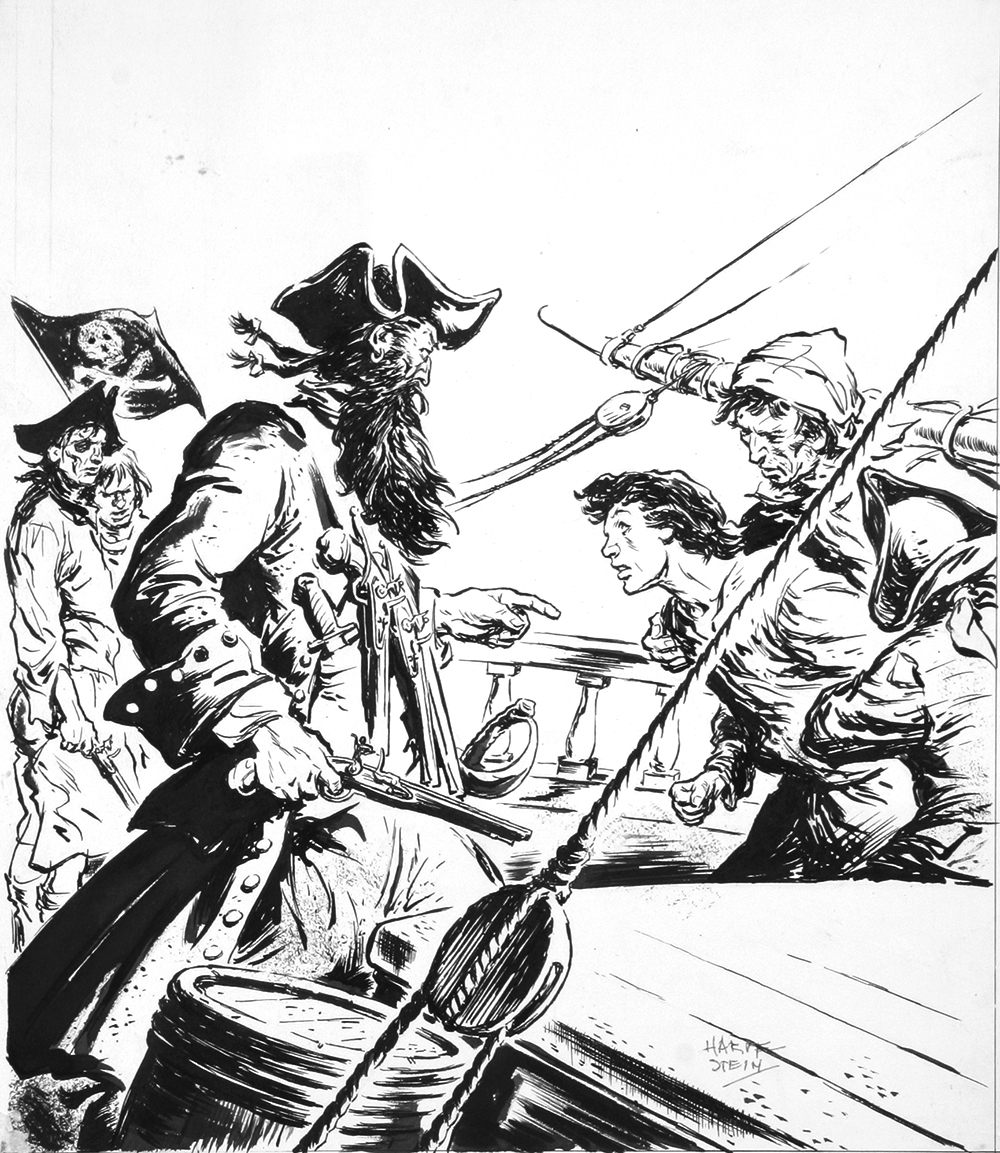
“Pirate Quest”
Cover illustration for the book by Nancy Faulkner
Published by Junior Press, Doubleday 1955
Brush and ink
Donated by the artist
